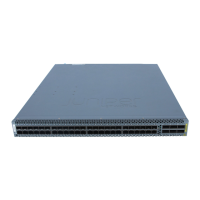to operate the receiver. See the specification for your receiver to find the maximum
receiver input power.
Before you begin to calculate the power margin:
•
Calculate the power budget. See “Calculating the Fiber-Optic Cable Power Budget for
a QFX Series Device” on page 132.
To calculate the worst-case estimate for the power margin (P
M
) for the link:
1. Determine the maximum value for link loss (LL) by adding estimated values for
applicable link-loss factors—for example, use the sample values for various factors
as provided in Table 42 on page 133 (here, the link is 2 km long and multimode, and
the (P
B
) is 13 dBm):
Table 42: Estimated Values for Factors Causing Link Loss
Sample (LL) Calculation ValuesEstimated Link-Loss ValueLink-Loss Factor
0.5 dBmMultimode—0.5 dBmHigher-order mode losses
(HOL)
0 dBmSingle-mode—None
0 dBmMultimode—None, if product of
bandwidth and distance is less
than 500 MHz/km
Modal and chromatic
dispersion
0 dBmSingle-mode—None
This example assumes five connectors. Loss for five
connectors: 5 (0.5 dBm) = 2.5 dBm
0.5 dBmConnector
This exampleassumes two splices. Loss for two splices:
2 (0.5 dBm) = 1 dBm
0.5 dBmSplice
This example assumes the link is 2 km long. Fiber
attenuation for 2 km: 2 km (1 dBm/km) = 2 dBm
Multimode—1 dBm/kmFiber attenuation
This example assumes the link is 2 km long. Fiber
attenuation for 2 km: 2 km (0.5 dBm/km) = 1 dBm
Single-mode—0.5 dBm/km
1 dBm1 dBmClock Recovery Module
(CRM)
NOTE: For information about the actual amount of signal loss caused by
equipment and other factors, see your vendor documentation for that
equipment.
2. Calculate the (P
M
) by subtracting (LL) from (P
B
):
P
B
– LL = P
M
133Copyright © 2012, Juniper Networks, Inc.
Chapter 8: Cable Specifications

